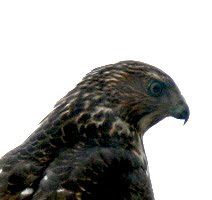Finally, photos of the hawk (s) that visits my deck once a year or so. In the photos he's perched on a Japanese maple.
No idea what kind of hawk he is? For size, that rod in front of him is about four inches of a window crank and it's about two feet in front of him.
Also, the foxes are back. Two small ones were on the deck early this morning when it was still dark.
Karen
Congratulations on getting the photos! As to what kind of hawk, check out that somewhat hyper-thyroid-ish look to the bird's face. That taken with what I'd take is a long tail, makes me think immature Accipiter.
Here is a crop of the bird's head. It doesn't appear smallish and very round compared to the body, so not a Sharp-shinned Hawk. Though it does have a white brow which a Cooper's immature doesn't have much in the way of--- Hmm. Those two are usually the two Accipiters that we're attempting to tell apart as Goshawks are scarce and getting more scarce all the time. Could this be an immature Northern Goshawk? Is the white brow stripe bold enough? The specific field marks for an immature Goshawk are a bold white brow stripe and irregular banding of the dark tail bands.
Anyone have a good familiarity with Goshawks?
NEXT A NEW YORK CITY RED-TAIL UPDATE
FROM HILARY, Washington Square Park Red-tail Observer
If you go to the park, look up at the hollow steel cross on top of the Judson Memorial Church on the south side of the park. The hawk was there this afternoon (11/21) at approximately 2:00 p.m. And blogger Zach has pictures posted of a hawk in the same location.
http://www.old-nyc.com/2009/04/wsp-hawk-on-judson-memorial.html
I heard what I thought sounded like an American Kestrel and when I looked up, a smaller bird swooped down on the hawk sitting on top of the cross before flying away from the park. However, it happened very quickly, so please take the kestrel ID with the caveats that a) I went to the park not expecting to see raptors! and b) I did not have bins... The RTH was perched the entire time I watched (about 20 minutes), keeping an eye on the very busy park with breaks for preening.
Many thanks Hilary for update!
And I haven't forgotten about talking about Owl feathers....honest.
Donegal Browne





